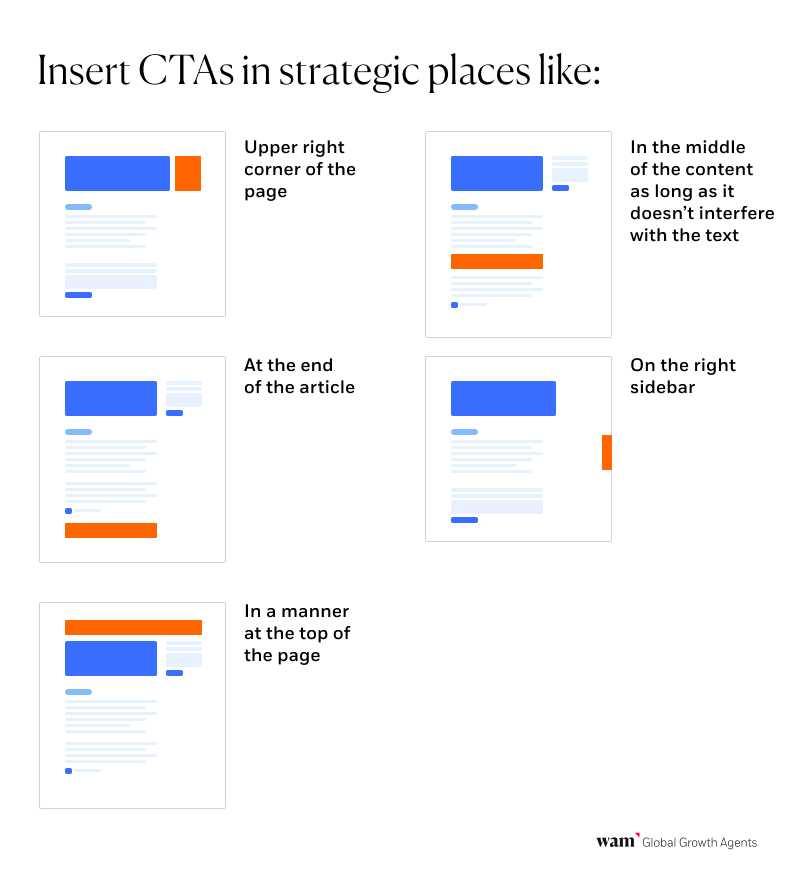Call to Action: how to optimize your CTAs to increase blog conversion
Today, we’re talking about the importance of these CTA buttons and we’ll share conclusions that can help you improve your CTA click ratio. When defining the digital marketing plan of your company, the conversion of different actions is one of the main goals. Call to Actions, or CTAs, are the visual element that accompany the user to this link, usually in the form of text on a button or web link. For email campaigns, CTAs are usually links to a webpage where the user can realize a number of actions.
Why are CTAs so important? The numbers speak for themselves and Protocol 80 has collected some of the most important ones:
- More than 90% of users that read your header will also see your CTA
- Emails are the only CTA that achieve 371% more clicks
- CTAs on a Facebook page increase CTR by 285%
One of the keys to ensuring that a CTA works is guaranteeing that all the CTA buttons match user expectations and indicate which action they should take and what they should expect after. All of this must be in the clearest and most concise form possible; without a clear CTA or action, the user may not understand the next steps to follow to buy a product or subscribe to a newsletter and it’s likely that they’ll leave the website without realizing said action.
CTAs in Digital Marketing
Within Content Marketing, CTAs can be used on product pages, ads, emails, social media, and anywhere else you want your offer to be seen; however, in this post, we’re going to focus on increasing your blog conversion while optimizing CTAs to the maximum. Each blog entry is an opportunity to include a button in line with the topic at hand. This way, you can increase the click percentage, given that it’s assumed that people who have read the article are truly interested in the topic and, therefore, in the added value that can be obtained from clicking a CTA.
It’s not just a simple button that we can place anywhere throughout the article. It’s more complicated than that, more strategic: we must truly study where to place it, the size, design, colors, language used, and more if we want it to truly be an instrument that generates sales (or the type of conversion that we’ve defined as a goal). In addition, CTAs and landing pages go hand in hand; each CTA must bring the visitor to a landing page where they immediately find what motivated them to click the CTA. This is another step in the conversion funnel.
The Importance of a CTA: designs and copies that achieve more clicks
Design and text are the two most important components to keep in mind when designing a CTA, given that they carry the weight of impacting the reader and achieving an increase in conversions. There are many kinds of Call to Actions, but they all have two things in common.
Design for Call to Actions
Design captures the attention of the user and shows them the path to follow to acquire the value added content that we added to the blog.
It’s not about finding the perfect CTA; this doesn’t exist. Depending on the content in which it is used, the design of the blog and, of course, the design of the landing page to which it leads, will need to meet a few requirements.
The only requirement that all must meet is to stand out from the rest of the elements of the page. Don’t listen to people who say that red CTAs turn users away; used correctly, they can work perfectly.
We also don’t recommend using combinations of artistic elements, visual effects, and more in marketing Call to Actions that improve visibility because they can have the opposite effect and distract the user, making them leave the page. However, for specific products or pages, these kinds of CTAs can be justified.
On occasion, an image helps a lot. Visual content helps to capture attention and is useful for showing the user the next step. Use images that help evoke the feeling we’re looking for in the user. It’s also important that they are adaptable; that’s why we always test how the Call to Action button appears on different devices (computer, phone, tablet). This is how we guarantee it works well on each of them.
It’s important that it’s visible, impossible to ignore. If we want more clicks, we must start by ensuring that visitors see the CTA button and also know that it’s clickable and not just an image. We have just 8 seconds before losing their attention; that’s why it must be placed in a key location. We use heat maps to discover how users navigate the site and find the right place.

A simple and direct CTA that we can identify at first glance is the best choice. And if you’re going to create one, why not create a few and test them on your audience?
Text: the key to a marketing call to action
Through the language we use, we can ensure that the user decides to take action. It’s about persuading the visitor, in whatever way necessary, to click on the CTA button. It’s not about giving orders like “Click here” as it can be annoying, nor using a message that transmits nothing like “click”.
The copy of the button must show a clear benefit that transmits value and makes it very clear to the user what they are going to achieve, but without reaching the “without this, you can’t live” tone that also creates failure. We should use short and coherent messages instead of long and descriptive sentences and test different copies to find out which works best. Normally, copies directed to the user work best and the words that appeal to urgency are most effective at increasing the conversion rate, probably because of the FOMO effect (fear of missing out).
Other Matters about CTA and Conversion
A report from the Digital Evolution Group lists other elements that you must keep in mind to optimize the conversion of your landing pages to the maximum, thanks to CTAs:
- Define the goal: the user must know exactly what will happen when they click on the CTA.
- Maintain the same appearance and language for the CTA and the landing page: this way, you won’t confuse or distract the user.
- Immediacy and urgency, but be careful: if the visitor feels intimidated and pressured, you can achieve an undesired effect. Expressions like “I want it now” or “Download today” are generally accepted.
- A button that looks like a button: the CTA and the need to click on it must stand out on the page. Play with the various options you have available to you on design programs and create borders, shadowing, contrasts, and formats that identify the button as a CTA.
- Guide the reader to the CTA: use symbols (arrows, for example) or create interactive CTAs that immediately capture the user’s attention.
- Insert CTAs in strategic places like:

No matter what the goal of your company or sector is, designing a strong call to action is fundamental to the success of your strategy. Don’t forget to test, test, and test! Using A/B tests to check the design, size, colors, or location of your CTAs and measuring their effectiveness through appropriate metrics will allow you to improve conversions and reduce the need to invest more in acquisition. Do you have any doubts about improving CTAs for your blogs? We’re here to help.
Subscribe to our newsletter and stay up to date with the latest digital trends.
Subscribe to our newsletter and stay up to date with the latest digital trends.
No thanks. My inbox is fine as it is.